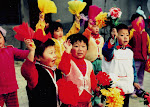 I'm continuing to post short articles about travel in China on Suite101. Here's a list of the stories I've posted since my February 1 round-up:
I'm continuing to post short articles about travel in China on Suite101. Here's a list of the stories I've posted since my February 1 round-up: - The ceramics museum at Yixing which we visited on our trip to Shanghai last year. This has some very old pottery and ceramics exhibits. Just outside the museum you can watch as artists craft teapots by hand.
- Chops, which I posted about on here earlier. I really enjoy using mine, though the red ink can get a bit messy.
- Beijing Botanical Garden which borders the Western Hills. I like it here as it's peaceful and not overrun by tourists. Plus you get to see some pretty good landscaping. Most people pass through here on the way to the Sleeping Buddha Temple.
- Longmen Grottoes at Luoyang are very famous examples of Buddhist art. Thousands of Buddhas ranging from a few inches to many, many feet are carved into caves on a hillside along the Yi River.
- Shanghai Museum is a definite must-see when you're in China's most populous city. Many people spend one or two days here, but you can get a quick overview in a few hours.
- Cuandixia which is a living history museum about 90k outside of Beijing. It's an old village which once shipped food to the Forbidden City, but is now turning itself into a tourist attraction to keep from becoming a ghost town. I snapped the above picture at Cuandixia. I've also posted another story about Cuandixia on my web site.
- Five lesser known museums in Beijing which are worth a visit after you've seen the major sites. They're not crowded like the big sites, and do provide another perspective about the Middle Kingdom.
For additional information on travel in China, please check out my web site. If you have questions about travel in China or ideas for stories you'd like to see, please feel free to email me.








